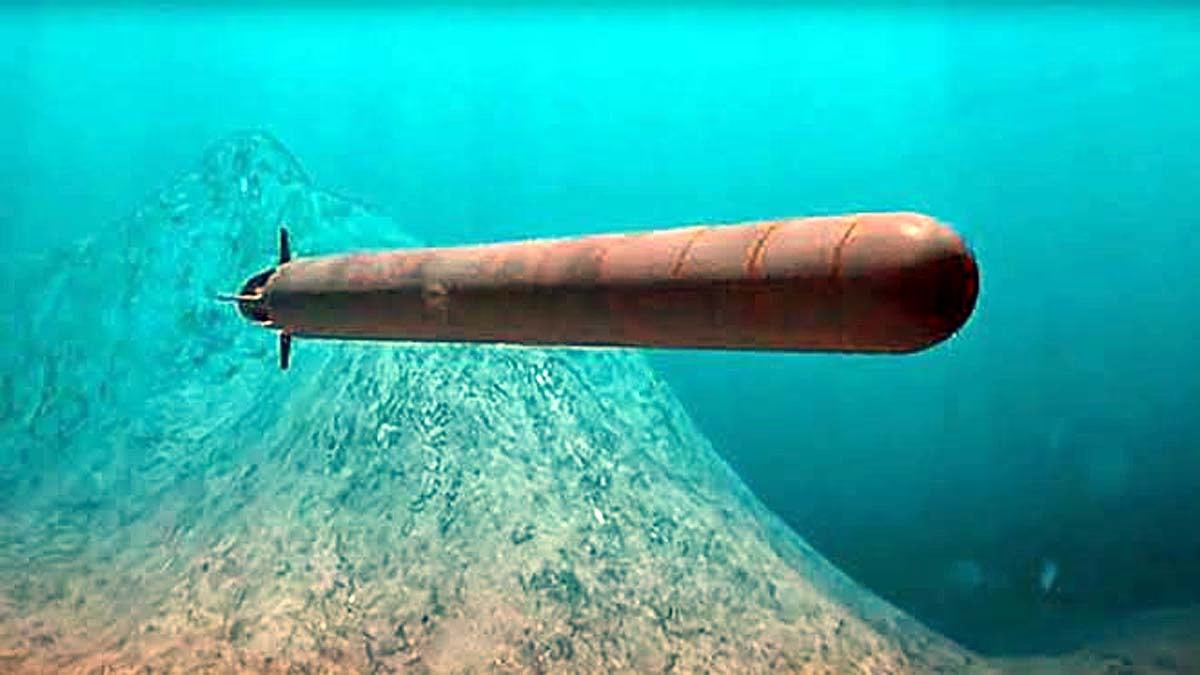China is developing a formidable new weapon known as a Nuclear Torpedo. This weapon has the potential to annihilate coastal cities through radioactive tsunamis. Inspired by Russia's Poseidon torpedo, China is set on crafting its own 'Doomsday' weapon.
What is a Nuclear Torpedo?
The Nuclear Torpedo is an underwater drone weapon equipped with nuclear warheads. The intent is to detonate near coastlines, generating massive radioactive tsunamis capable of obliterating coastal cities and naval bases. Beyond physical destruction, it could render areas uninhabitable due to radioactive contamination.
Also read:
China's torpedo, modeled after Russia's Poseidon debuted by the Russian Navy in 2015, claims to be smaller, cost-effective, and mass-producible. Launched from submarines or warships, it can navigate the ocean floor evading enemy radar.
Features of China's Nuclear Torpedo
According to a report by the Eurasian Times, revealed in China Shipbuilding Industry Corporation's Journal of Unmanned Undersea Systems, here are its key features:
Powered by nuclear energy: It uses a mini nuclear reactor that propels it at 30 knots (56 km/h) for 200 hours underwater.
Range: It can traverse the Pacific Ocean in a week, suggesting a range of thousands of kilometers.
Size: Smaller than Russia's Poseidon (65 feet long, 2 meters wide), allowing easier launches through standard torpedo tubes.
Warheads: Initially carries conventional explosives but can be upgraded with nuclear warheads.
Objective: Target coastal cities, naval bases, and infrastructure. Potentially threatens countries like the USA, Japan, and South Korea.

Source: aajtak
Inspired by Russia's Poseidon
The Russian Poseidon torpedo, also known as Canyon or Status-6, is the world's first nuclear-powered torpedo. Noted for carrying up to a 100-megaton nuclear warhead, it operates at 70-100 knots and depths of 3300 feet, making it nearly unstoppable. Russia claims it can unleash a 500-meter-high radioactive wave to devastate coastal cities.
January 2023 marked the completion of the first batch of Poseidons, to be deployed in the Belgorod submarine. A failed test in November 2022 cast doubts on its reliability. China's torpedo, being smaller, suits mass production and deployment.
Also read:
What is a Radioactive Tsunami?
A radioactive tsunami is a devastating wave created by a nuclear explosion. It could wreak havoc in coastal regions by making sea waters radioactive. Its impacts include:
Destruction: Submerging coastal cities, destroying infrastructure, and displacing millions.
Radiation: Contaminating regions long-term, rendering them uninhabitable.
Environmental damage: Marine ecosystems such as fish and coral reefs could be wiped out. The 1946 Bikini Atoll nuclear test severely damaged marine life.
Some experts believe inducing tsunamis with nuclear torpedoes isn't straightforward. David Hambling told Euronews immense energy is required, possibly more than nuclear explosions provide. However, detonating near coasts can still cause city-wide destruction.
Also read:
China's Strategy: Why Build Such a Weapon?
China's endeavor is inspired by Russia's Poseidon and global defense competition. Some reasons include:
Tensions in Indo-Pacific:
The AUKUS agreement among the USA, UK, and Australia plans nuclear submarine deployment in the South China Sea, perceived as a provocation by China.
Pressure on Taiwan:
The launch of China's third aircraft carrier Fujian, named after a province neighboring Taiwan, intensifies Taiwan-related threats.
Strategic Intimidation:
Developed to instill fear in the USA and allies like Japan and South Korea, this weapon also serves as a psychological and intimidation tool.
Also read:
Legal and Ethical Concerns
According to a report by the Center for International Maritime Security (CIMSEC), using nuclear torpedoes may violate international laws of war:
Environmental damage: Under the Environmental Modification Convention (ENMOD) and the Geneva Convention's Protocol I (AP I), weapons causing long-term environmental harm are unlawful.
Civilian harm: Causing casualties and mass displacement in coastal cities breaches laws of warfare.
Lack of control: As an automated, remote-controlled drone, risks of miscommunication or hacking rise.
Also read:
Global Responses
USA:
Former U.S. official Christopher Ford warned in 2020 that the weapon could destroy American coastal cities.
Norway:
Norwegian intelligence service chief Nils Stensønes expressed concerns over environmental risks.
Expert Opinions:
James Mattis, ex-U.S. Secretary of Defense, considers the weapon unlikely to shift strategic balance, due to existing nuclear arsenals of Russia and China.
Is This Weapon Truly a Feasibility?
Some believe claims of radioactive tsunamis might be exaggerated. A Meta-Defense report suggests the torpedo may not be as effective as publicized. It might primarily serve psychological warfare and exert pressure in arms control dialogues.




